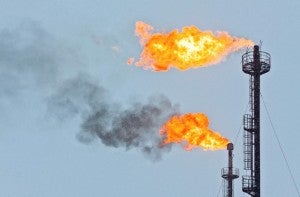 Nearly every month, for the past six months, a new scientific study has been released that provides new insights in to where methane, a highly potent, climate-destabilizing greenhouse gas, could be reduced across the entire natural gas system – the next six months will be no different. But this week, a new joint Purdue-Cornell study published in the Proceedings of the National Academy of Sciences revealed high emissions from drilling.
Nearly every month, for the past six months, a new scientific study has been released that provides new insights in to where methane, a highly potent, climate-destabilizing greenhouse gas, could be reduced across the entire natural gas system – the next six months will be no different. But this week, a new joint Purdue-Cornell study published in the Proceedings of the National Academy of Sciences revealed high emissions from drilling.
Energy Exchange
High Methane Emissions in PA Reinforce Need for Strong Regulation
Another Major Methane Study Shows Action is Needed Now to Reduce Emissions
 This commentary originally appeared on the EDF Voices Blog.
This commentary originally appeared on the EDF Voices Blog.
Mounting scientific evidence underscores the crucial importance of reducing methane emissions in the U.S. The latest study, published today in the journal Science, reviewed available data from the past 20 years and found that methane emissions from the U.S. natural gas supply chain are almost two times greater than current official estimates – flagging once again that methane emissions are a serious problem. However, the Stanford-led team also concluded that the current levels of methane leakage negates the climate benefit of switching to natural gas under some scenarios and not others, such as moving from coal-powered to natural gas electric generation.
As for what contributes to the higher than expected emissions, the study authors cited differing measurement techniques—including “bottom-up” direct measurement at the source, “top-down” readings from aircraft, and others—as well as the presence of “super-emitters” (a small number of sites or pieces of equipment producing a large share of emissions). Super-emitters are not easily sampled using most bottom-up direct measurement approaches. The team also spotlighted challenges associated with an increasingly ambiguous distinction between emissions from natural gas and oil production, both of which contribute methane to the atmosphere.
New Study Underscores Urgent Need to Reduce Methane Emissions from Natural Gas Operations
 You may have seen news reports about a new methane emissions study conducted by climate researchers from Harvard and seven other institutions and just published in Proceedings of the National Academy of Sciences (PNAS). The new paper provides an improved estimate of the total methane budget of the US – in other words, how much methane is being released into the atmosphere each year from all sources, including livestock and oil-and-gas production.
You may have seen news reports about a new methane emissions study conducted by climate researchers from Harvard and seven other institutions and just published in Proceedings of the National Academy of Sciences (PNAS). The new paper provides an improved estimate of the total methane budget of the US – in other words, how much methane is being released into the atmosphere each year from all sources, including livestock and oil-and-gas production.
Based on analysis of nearly 5,000 air samples collected in 2007 and 2008 from ten communications towers located around the country, as well as 7,700 samples taken in those years from an aircraft monitoring program, the study finds that total methane emissions due to human activity were roughly 1.5 times greater at that time than previously estimated. Emissions from livestock were roughly twice as high as previous estimates. Emissions from oil-and-gas operations in Oklahoma and Texas were 2.7 times higher than estimated.
We are glad to see the methane issue getting the attention it deserves. While EDF’s work to deepen our understanding of current emissions continues, there’s no question about the need for regulation to measure and reduce these emissions. In August, scientists with the National Oceanic and Atmospheric Administration (NOAA) and the University of Colorado (UC) at Boulder published a long-awaited paper on methane leakage in the journal Geophysical Research Letters that reported an alarmingly high level of methane emissions in the Uintah Basin of Utah — 6.2 to 11.7 percent of total production for an area about 1,000 square miles. Read More
Methane: a Key to Dealing With Carbon Pollution?
 Carbon is typically considered enemy number one in the context of climate-altering pollution. There is good reason why. Carbon dioxide (CO2) emitted from power plants is the leading source of U.S. greenhouse (GHG) emissions. Beyond our borders, the historic level of 400 parts per million of GHGs entering into our earth’s atmosphere was passed just five months ago – an indication of the rapid rise in human-produced emissions.
Carbon is typically considered enemy number one in the context of climate-altering pollution. There is good reason why. Carbon dioxide (CO2) emitted from power plants is the leading source of U.S. greenhouse (GHG) emissions. Beyond our borders, the historic level of 400 parts per million of GHGs entering into our earth’s atmosphere was passed just five months ago – an indication of the rapid rise in human-produced emissions.
And while reducing carbon pollution is the primary goal of EDF’s climate agenda, so is minimizing methane emissions from natural gas development. That’s because methane, the main ingredient in natural gas, is a powerful GHG that can cause major climate damage in the short term. In fact, a recent analysis by many of the world’s top experts on evolving climate science, the Intergovernmental Panel on Climate Change (IPCC), reports methane to be at least 84 times more potent than CO2 over the first two decades. On a 100-year timeframe, methane is at least 28 times more potent. These are noticeable changes in methane’s Global Warming Potential (GWP) from the IPCC’s last assessment in 2007, with values raised from 72 to 84 and 25 to 28, roughly a 17 percent increase on a 20-year time horizon and a 12 percent increase on a 100-year basis.
IPCC’s fifth assessment (AR5) also quantitatively discusses two additional indirect effects that further increase, albeit modestly, methane’s GWP. First, IPCC considers climate-carbon feedbacks and reports two sets of GWP values: one that accounts for the feedbacks and another that excludes them (they conclude that including this effect is “likely” to give a more accurate estimate of climate impacts from emissions of greenhouse gases like methane or CH4). The 20-year GWP for methane with feedbacks increases from 84 to 86, with the 100-year GWP up from 28 to 34. The explanation for this feedback is diminishing ability of oceans and soils to absorb carbon dioxide as the climate warms. As a result, as methane emissions warm the climate, more CO2 that would have historically been absorbed by the land and ocean remains in the atmosphere, causing additional warming. The second effect now quantified by the IPCC is the production of additional CO2 as CH4 is oxidized in the atmosphere, which adds another point or two to methane’s GWP.
New Warnings About Methane Emissions
 Concerns about the methane problem associated with the U.S. natural gas boom are mounting with each study released. This week scientists with the National Oceanic and Atmospheric Administration (NOAA) and the University of Colorado (UC) at Boulder published a new paper on methane leakage in the journal Geophysical Research Letters. It reports an alarmingly high level of methane emissions in the Uintah Basin of Utah — 6.2 to 11.7 percent of total production for an area about 1,000 square miles. Findings are based on readings from airplane flights that measured methane in the air on a single day and estimated the proportion of those emissions that came from the oil and gas infrastructure —production, gathering systems, processing and transmission of the gas out of the region. The authors calculated the uncertainty of their measurements, finding a 68 percent chance the leak rate is between 6.2 and 11.7 percent, and a 95 percent chance it is between 3.5 and 14 percent.
Concerns about the methane problem associated with the U.S. natural gas boom are mounting with each study released. This week scientists with the National Oceanic and Atmospheric Administration (NOAA) and the University of Colorado (UC) at Boulder published a new paper on methane leakage in the journal Geophysical Research Letters. It reports an alarmingly high level of methane emissions in the Uintah Basin of Utah — 6.2 to 11.7 percent of total production for an area about 1,000 square miles. Findings are based on readings from airplane flights that measured methane in the air on a single day and estimated the proportion of those emissions that came from the oil and gas infrastructure —production, gathering systems, processing and transmission of the gas out of the region. The authors calculated the uncertainty of their measurements, finding a 68 percent chance the leak rate is between 6.2 and 11.7 percent, and a 95 percent chance it is between 3.5 and 14 percent.
This follows two other regional studies conducted by scientists at the same organizations. One released last May in the Journal of Geophysical Research reported a 17 percent methane leak rate for the Los Angeles Basin, which has received quite a bit of attention although, as I’ll explain below, the figure can be misleading. The second study, conducted over the Denver-Julesburg Basin in 2008, found 4 percent of the methane produced at an oil and gas field near Denver at that time was escaping into the atmosphere. Taken together, these studies are troubling. They should be regarded as alarm bells ringing in our ears. Action by policymakers and industry is needed now.
Any amount of methane lost from the natural gas supply chain should be eliminated whenever possible. That’s because methane retains heat much more effectively relative to carbon dioxide: Over the first 20 years, an ounce of methane traps in heat 72 times more efficiently. Even small amounts vented or released as “fugitives” – unintentional methane leaked as gas moves from the field to your doorstep – can reduce or eliminate the climate advantage we think we’re getting when we substitute natural gas for coal or oil.
Measuring Fugitive Methane Emissions
 In recent days, news reports and blog posts have highlighted the problem of fugitive methane emissions from natural gas production — leakage of a potent greenhouse gas with the potential to undermine the carbon advantage that natural gas, when combusted, holds over other fossil fuels. These news accounts, based on important studies in the Denver-Julesburg Basin of Colorado and the Uinta Basin of Utah by scientists affiliated with the National Oceanic and Atmospheric Administration (NOAA) and the University of Colorado (UC) at Boulder, have reported troubling leakage rates of 4% and 9% of total production, respectively —higher than the current Environment Protection Agency (EPA) leakage estimate of 2.3%.
In recent days, news reports and blog posts have highlighted the problem of fugitive methane emissions from natural gas production — leakage of a potent greenhouse gas with the potential to undermine the carbon advantage that natural gas, when combusted, holds over other fossil fuels. These news accounts, based on important studies in the Denver-Julesburg Basin of Colorado and the Uinta Basin of Utah by scientists affiliated with the National Oceanic and Atmospheric Administration (NOAA) and the University of Colorado (UC) at Boulder, have reported troubling leakage rates of 4% and 9% of total production, respectively —higher than the current Environment Protection Agency (EPA) leakage estimate of 2.3%.
While the Colorado and Utah studies offer valuable snapshots of a specific place on a specific day, neither is a systematic measurement across geographies and extended time periods and that is what’s necessary to accurately scope the dimensions of the fugitive methane problem. For this reason, conclusions should not be drawn about total leakage based on these preliminary, localized reports. Drawing conclusions from such results would be like trying to draw an elephant after touching two small sections of the animal’s skin: the picture is unlikely to be accurate. In the coming months, ongoing work by the NOAA/UC team, as well as by Environmental Defense Fund (EDF) and other academic and industry partners, will provide a far more systematic view that will greatly increase our understanding of the fugitive methane issue, though additional studies will still be needed to fully resolve the picture. What follows is a briefing on the fugitive methane issue, including the range of measurements currently underway and the need for rigorous data collection along the entire natural gas supply chain.
Why methane leakage matters. Natural gas, which is mostly methane, burns with fewer carbon dioxide emissions than other fossil fuels. However, when uncombusted methane leaks into the atmosphere from wells, pipelines and storage facilities, it acts as a powerful greenhouse gas with enormous implications for global climate change due to its short-term potency: Over a 20-year time frame, each pound of methane is 72 times more powerful at increasing the retention of heat in the atmosphere than a pound of carbon dioxide. Based on EPA’s projections, if we could drastically reduce global emissions of short-term climate forcers such as methane and fluorinated gases over the next 20 years, we could slow the increase in net radiative forcing (heating of the atmosphere) by one third or more.
Fugitive methane emissions from natural gas production, transportation and distribution are the single largest U.S. source of short-term climate forcing gases. The EPA estimates that 2.3% of total natural gas production is lost to leakage, but this estimate, based on early 1990’s data, is sorely in need of updating. The industry claims a leakage rate of about 1.6%. Cornell University professor Robert Howarth has estimated that total fugitive emissions of 3.6 to 7.9% over the lifetime of a well.
To determine the true parameters of the problem, EDF is working with diverse academic partners including the University of Texas at Austin, the NOAA/UC scientists and dozens of industry partners on direct measurements of fugitive emissions from the U.S. natural gas supply chain. The initiative is comprised of a series of more than ten studies that will analyze emissions from the production, gathering, processing, long-distance transmission and local distribution of natural gas, and will gather data on the use of natural gas in the transportation sector. In addition to analyzing industry data, the participants are collecting field measurements at facilities across the country. The researchers leading these studies expect to submit the first of these studies for publication in February 2013, with the others to be submitted over the course of the year. Read More









